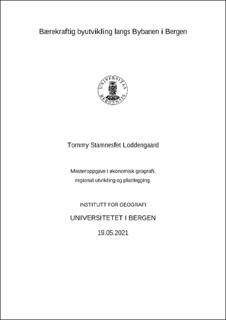| dc.contributor.author | Loddengaard, Tommy Stamnesfet | |
| dc.date.accessioned | 2021-06-16T23:59:37Z | |
| dc.date.available | 2021-06-16T23:59:37Z | |
| dc.date.issued | 2021-05-19 | |
| dc.date.submitted | 2021-06-16T22:00:15Z | |
| dc.identifier.uri | https://hdl.handle.net/11250/2759837 | |
| dc.description.abstract | Den kompakte byen og bærekraftig utvikling knyttet til transportinfrastrukturer er sentrale tema for denne oppgaven. Infrastrukturtiltak for ulike transportformer har stor betydning for en miljø- og klimavennlig byutvikling, og de gjeldende overordnede målsetningene FNs bærekraftsmål danner grunnlaget for hvordan de regionale og kommunale planene skal føre til en bærekraftig utvikling. Bergen kommunes arealdel (KPA, 2019) bygger derfor på overordnede føringer gitt gjennom regionale og statlige planer og retningslinjer. Fellesnevneren i disse dokumentene er behovet for et bærekraftig utbyggingsmønster og nullvekst i biltrafikken. For å møte målene er høy arealutnyttelse rundt kollektivknutepunktene den gjeldende strategien. Tematikken omkring dette blir adressert gjennom min hovedproblemstilling, som er «Hvordan kan Bybanen til Fyllingsdalen fungere som et redskap for bærekraftig byutvikling?». For å gå dypere inn i hvordan de ulike styringsnivåene spiller inn i byutviklingen har jeg også formulert to underproblemstillinger. (Ⅰ): «På hvilken måte er bærekraftsmålene intendert til å ha en transformerende kraft på lokalitetene Oasen, Mindemyren og Fløen/Møllendal?». Og (Ⅱ): «På hvilken måte blir bærekraftsmålene realisert i plan- og realiseringsprosessen?». For å underbygge mine diskusjoner bygger mitt teoretiske rammeverk på teorier og begreper innenfor bærekraft, planlegging, fortetting, konflikt og kompleksitet. Litteraturen viser blant annet noen utfordringer og muligheter som gjenspeiler det Bergen kommune opplever ved etablering av Bybanen til Fyllingsdalen. For å samle inn empirisk data har jeg primært brukt semistrukturert intervju og dokumentanalyse som mine kvalitative metoder. Funnene i studien viser at det en rekke ulike meninger om hvordan FNs bærekraftsmål blir brukt i planleggingen, men at fellesnevneren er at målene antas å være tolket, sektorisert og iverksatt i de lokale kommuneplanene; samfunnsdelen (KPS, 2015) og arealdelen (KPA, 2019). De overordnede strategiene inneholder også tolkningsrom, og generelt har målformuleringene på overordnet plannivå ofte vanskeligheter for å bli operasjonalisert til lokalt nivå. Generelt sett har bærekraftsmålene hatt en mobiliserende effekt av forskjellige aktører, der blant annet Bybanen kan spille en viktig rolle innenfor bærekraftig transport og areal. Studien konkluderer med at Bybanen kan bidra til en bærekraftig utvikling, hvis utviklingen foregår etter de lokalt satte visjonene og målene, som går ut på at ubrukt grøntareal (byspredning) ikke foregår og at det som bygges ut har fokus på sosial bærekraft. | |
| dc.description.abstract | The compact city and sustainable development related to transport-infrastructures are key topics for this thesis. Infrastructure measures for various modes of transport are of great importance for environmentally and climate-friendly urban development, and the current overarching objectives of the UN's sustainability goals form the basis for how the regional and municipal plans are to lead to sustainable development. Bergen municipality's area-plan (KPA, 2019) is therefore based on general guidelines given through regional and state plans and guidelines. The common denominator in these documents is the need for a sustainable development pattern and zero growth in car traffic. To meet the goals, high area utilization around the public transport hubs is the current strategy. The theme around this is addressed through my research question "How can the light rail (Bybanen) to Fyllingsdalen function as a tool for sustainable urban development?". To go in depth in how the different levels of government play a role in urban development, I have also formulated two sub- research questions (Ⅰ): «In what way are the sustainability goals intended to have a transforming power at the localities Oasen, Mindemyren and Fløen / Møllendal?». And (Ⅱ): "In what way are the sustainability goals realized in the planning and realization process?". To support my discussions, my theoretical framework is based on theories and concepts within sustainability, planning, densification, conflict and complexity. The literature shows, among other things, some challenges and opportunities that reflect what Bergen municipality is experiencing when establishing the light rail to Fyllingsdalen. For my empirical data, I have primarily used semi-structured interviews and document analysis as a qualitative method. The findings of the study show that there are several different opinions about how the UN's sustainability goals are used in planning, but that the common denominator is that the goals are assumed to be interpreted, sectorized and implemented in the local municipal plans; community-part (KPS, 2015) and the area-part (KPA, 2019). The overall strategies also contain room for interpretation, and in general the goal formulations at the overall plan level often have difficulties in being operationalized to the local level. In general, the sustainability goals have had a mobilizing effect of various actors, where, among other things, the light rail can play an important role in sustainable transport and area. The study concludes that the light rail can contribute to sustainable development, if the development takes place according to the locally set visions and goals, which means that unused green space (urban sprawl) does not take place and further development has a strong focus on social sustainability. | |
| dc.language.iso | nob | |
| dc.publisher | The University of Bergen | |
| dc.rights | Copyright the Author. All rights reserved | |
| dc.subject | byutvikling | |
| dc.subject | Bergen | |
| dc.subject | Bybane | |
| dc.subject | Bærekraft | |
| dc.title | Bærekraftig byutvikling langs Bybanen i Bergen | |
| dc.type | Master thesis | |
| dc.date.updated | 2021-06-16T22:00:15Z | |
| dc.rights.holder | Copyright the Author. All rights reserved | |
| dc.description.degree | Masteroppgave i geografi | |
| dc.description.localcode | GEO350 | |
| dc.description.localcode | MPGEOGR | |
| dc.description.localcode | MASV-GEOG | |
| dc.description.localcode | MASV-PHYG | |
| dc.description.localcode | MASV-MEHA | |
| dc.subject.nus | 733111 | |
| fs.subjectcode | GEO350 | |
| fs.unitcode | 15-41-0 | |
